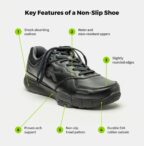Look for a rubber or textured sole and a network of grooves intended to provide traction and grip on slick surfaces when evaluating if shoes are non-slip. These features enhance stability and reduce the risk of slipping and falling.
Non-slip shoes are essential for professions that require working in wet or hazardous environments, as well as for activities such as hiking or sports that involve uneven terrain. Wearing non-slip shoes not only helps prevent accidents but also provides peace of mind and confidence while navigating slick surfaces.
It is important to prioritize safety by selecting the right footwear to avoid potential injuries and mishaps.
Understanding Non-Slip Shoes
Slipping and falling can be a major concern when it comes to footwear, especially in certain environments such as restaurant kitchens, hospitals, or construction sites. That’s where non-slip shoes come into play. Designed to provide better traction and grip, non-slip shoes are a popular choice for anyone looking to avoid accidents and stay on their feet.
Let’s examine non-slip shoes in more detail, along with the materials that went into making them and how they vary from other types of footwear.
What Are Non-Slip Shoes?
Non-slip shoes, sometimes referred to as slip-resistant shoes, are specifically designed footwear that is resistant to slipping and sliding on various surfaces. These shoes are equipped with special soles that provide better traction, preventing accidents caused by slipping on wet or oily floors.
To protect workplace safety, several businesses, including the hospitality, healthcare, and industrial sectors, mandate that personnel use non-slip shoes as part of their uniform.
Key points:
- Non-slip shoes are designed to prevent slipping and sliding on various surfaces.
- They are commonly required in industries where slip accidents are a concern, such as hospitality, healthcare, and manufacturing.
Materials Used In The Construction Of Non-Slip Soles
Non-slip shoe soles are made from specific materials that enhance grip and traction. These materials are carefully chosen to provide maximum friction with the ground, reducing the risk of accidents: The following materials are frequently used to make non-slip soles:
- Rubber: Due to its inherent flexibility and grip, rubber is a popular material.
- Tread patterns: Non-slip soles often feature intricate tread patterns that increase surface contact and enhance grip. These patterns vary depending on the intended use of the shoes.
- Outsole additives: Certain additives, such as carbon or silica, can be incorporated into the sole material to further improve traction. These additives increase friction, making the shoe even more slip-resistant.
Key points:
- Non-slip soles are made from materials that enhance grip and traction.
- Rubber, tread patterns, and outsole additives are common features of non-slip shoe soles.
How Non-Slip Shoes Differ From Regular Shoes
In addition to having a different sole design from conventional shoes, non-slip shoes also have a different overall design. These differences are essential for providing the necessary traction and stability to prevent slips and falls. Here are a few ways non-slip shoes stand apart from regular shoes:
- Sole design: Non-slip shoe soles typically have deeper treads and grooves to increase traction. These patterns help channel liquids away from the shoe’s contact surface, minimizing the risk of slipping on wet floors.
- Support and stability: Non-slip shoes often feature enhanced arch support, cushioning, and ankle stability. These features help maintain balance and prevent foot fatigue, promoting improved safety in challenging environments.
- Water resistance: Many non-slip shoes are water-resistant or have waterproof uppers. This feature helps keep feet dry and prevents water from seeping into the shoe, reducing the likelihood of slips caused by wet feet.
Key points:
- Non-slip shoes have specific sole designs to increase traction and minimize slipping.
- These shoes often offer enhanced support and stability to promote safety in demanding environments.
- Water-resistant or waterproof features are commonly found in non-slip shoes to prevent slips caused by wet conditions.
Non-slip shoes are an excellent choice for anyone seeking added safety and security while navigating potentially slippery surfaces. By understanding what makes these shoes unique, you can make an informed decision when selecting footwear to protect yourself from accidents caused by slips and falls.
Factors To Consider
There are several things to think about while selecting the best pair of non-slip footwear. Making an informed decision is crucial, as slip and fall accidents can be both painful and dangerous. By paying attention to certain key indicators, you can ensure that the shoes you choose provide the necessary traction and grip to keep you safe on slippery surfaces.
Here, we’ll examine many aspects to take into account when figuring out whether a pair of shoes is indeed non-slip.
Traction And Grip: Key Indicators Of Non-Slip Shoes
- Non-slip shoes should offer excellent traction and grip on different surfaces.
- The ability to maintain a stable footing helps prevent accidents caused by slippery floors or uneven terrain.
- Adequate traction ensures that you can confidently walk, run, or stand without the fear of sliding or losing balance.
Rubberized Soles: Enhanced Traction For Slippery Surfaces
- Rubberized soles are often a telltale sign of non-slip shoes.
- The rubber material enhances grip and provides better traction, particularly on slick or wet surfaces.
- Shoes with rubber outsoles tend to have superior durability, making them ideal for environments where slip resistance is of utmost importance.
Deep Treads: Increased Grip On Wet Or Oily Surfaces
- Deep treads on the outsole of a shoe improve its grip on wet, oily, or slippery surfaces.
- The design allows the shoe to channel water, oil, and debris away, providing a secure footing.
- Deep-treaded shoes are particularly beneficial in industries like hospitality, healthcare, and manufacturing, where workers are regularly exposed to potential slip and fall hazards.
Traction Ratings: Industry Standards To Look For
- Look for shoes that meet specific traction ratings set by industry standards.
- These ratings indicate the shoes’ grip performance on various surfaces, including oily, wet, or non-slip conditions.
- Always opt for shoes with higher traction ratings, as they offer increased slip resistance and provide more confidence in slippery environments.
Slip-Resistant Outsoles: Durability And Effectiveness
- Slip-resistant outsoles are a reliable indicator of non-slip shoes.
- These specially designed outsoles provide excellent grip on different surfaces, reducing the risk of accidents.
- They offer durability and effectiveness, ensuring that the non-slip properties of the shoes are long-lasting and reliable.
Characteristic Patterns: Identifying Slip-Resistant Designs
- Slip-resistant shoes often feature specific patterns on their outsoles.
- These patterns enhance grip and traction, allowing you to maintain stability even on slippery surfaces.
- Look for shoes with characteristic patterns like herringbone, hexagonal, or micro-channel designs, as they are specifically engineered to prevent slips.
Outsole Markings: Symbols And Labels Indicating Slip Resistance
- Pay attention to symbols and labels on the shoes’ outsoles, as they serve as indicators of slip resistance.
- Look for markings like “sr” (slip-resistant) or a slip-resistant logo.
- These markings confirm that the shoes have undergone testing and meet certain slip-resistant standards.
Water And Oil Resistance: Essential Features Of Non-Slip Shoes
- Non-slip shoes should possess water and oil resistance properties to maintain their slip-resistance.
- Water-resistant fabrics keep moisture from condensing, which lowers the chance of skidding on damp surfaces.
- Oil-resistant features ensure that oil spills or greasy floors do not compromise the shoes’ grip.
Benefits Of Water And Oil Resistance
- Water and oil resistance extends the lifespan of non-slip shoes by protecting against deterioration caused by liquids.
- Shoes that resist water and oils are easier to clean and maintain, making them ideal for professional settings.
- These properties also help maintain the shoes’ slip resistance, ensuring the safety of the wearer.
Testing Methods For Water And Oil Resistance
- Shoes are often subjected to testing methods to determine their water and oil resistance.
- These tests include exposing the shoes to water, oil spills, or other liquids to evaluate their performance.
- Look for shoes that have undergone such rigorous testing to ensure their effectiveness in real-world situations.
As you embark on your quest for non-slip shoes, consider these factors carefully to find a pair that provides the necessary traction, durability, and slip resistance. By choosing footwear that meets industry standards and encompasses essential features like rubberized soles, deep treads, and water and oil resistance, you can step with confidence and keep accidents at bay.
Testing Shoe Slip Resistance
Slipping and falling are among the most common workplace accidents, and choosing the right pair of non-slip shoes can help prevent such mishaps. But how can you determine if a pair of shoes is truly non-slip? Here are some key factors to consider when testing shoe slip resistance:
Examine The Outsole Pattern And Material:
- Look for shoes with a well-designed outsole pattern. This pattern should feature deep grooves and a multidirectional tread to enhance traction.
- Shoes with rubber or polyurethane outsoles tend to provide better slip resistance than those with leather or synthetic materials.
Studying The Tread Depth And Pattern:
- Measure the depth of the shoe’s tread. The deeper the treads, the better the shoe’s grip.
- A zigzag or square pattern on the outsole can help create more friction, reducing the chances of slipping.
Assessing The Composition Of The Outsole:
- Check the flexibility of the shoe’s outsole. A flexible outsole allows for better contact with the ground, improving traction.
- Look for shoes with outsoles that are resistant to wear and tear, as this can ensure the durability and continued slip resistance of the footwear.
Conducting The Water Test:
- Water is a common cause of slips, so testing a shoe’s resistance to water can help determine its slip resistance.
- Wet the outsole of the shoe and step onto a wet surface. Observe if the shoe maintains its grip or if it slides easily.
Steps To Determine Water Resistance:
- Check if the shoe has a water-resistant upper material. Materials like leather, nylon, or synthetic fabrics can repel water to some extent.
- Look for shoes with sealed seams and waterproof linings to prevent water from seeping inside.
- Choose shoes with water-dispersing channels or grooves on the outsole, which can help in maintaining traction on wet surfaces.
Observing The Shoe Performance On Wet Surfaces:
- Take note of how the shoes perform on wet surfaces during regular use. If they maintain good traction and prevent slips, they are likely to be non-slip.
Evaluating Oil Resistance:
- Oil spills or leaks are common in many work environments, making oil resistance an essential characteristic of non-slip shoes.
- Look for shoes with outsoles made of oil-resistant materials like rubber or nitrile, as these provide better grip on oily surfaces.
How To Check If Shoes Repel Oil:
- Apply a small amount of oil on the outsole and observe if it spreads or stays in place.
- If the oil forms beads or slides off the outsole, it indicates that the shoe has oil-repellent properties.
Testing Shoes On Oily Surfaces:
- For a more accurate assessment, step onto an oily surface and observe the shoe’s performance.
- Non-slip shoes should maintain their grip and prevent slips, even on slippery or greasy surfaces.
By considering these factors, examining the shoe’s outsole pattern, material, tread depth, composition, water resistance, and performance on wet and oily surfaces, you can determine whether a pair of shoes is truly non-slip. Prioritizing slip resistance will help ensure safety and prevent accidents in various working conditions.
Additional Considerations
When it comes to choosing non-slip shoes, there are a few additional considerations you should keep in mind to ensure you find the perfect pair. Here are some key factors to consider:
Comfort And Fit: The Importance Of A Well-Fitting Shoe
- A well-fitting shoe is essential for both comfort and safety.
- Look for shoes with a comfortable and spacious toe box to prevent squishing and discomfort.
- Opt for shoes with ample cushioning to provide support and reduce pressure on your feet.
- Consider the overall fit of the shoe, ensuring it hugs your foot securely without being too tight or loose.
Foot Support And Cushioning
- Non-slip shoes should provide adequate support for your feet to prevent fatigue and discomfort.
- Look for shoes with built-in arch support to maintain proper alignment and reduce strain on your arches.
- Cushioning is crucial to absorb shock and provide extra comfort, especially if you’ll be on your feet for extended periods.
Arch Support: Enhancing Stability And Balance
- Arch support is essential for stability and effective weight distribution.
- Shoes with good arch support help prevent overpronation or supination, which can lead to imbalance and potential accidents.
- Look for shoes with arch support features like molded or removable insoles to customize your level of support.
Shoe Type And Style Options For Non-Slip Shoes
Non-slip shoes come in various styles to suit different needs. Consider the following options:
Non-Slip Athletic Shoes
- Non-slip athletic shoes are ideal for activities that require agility and quick movements.
- Look for shoes with a flexible sole to promote natural foot movement during physical activities.
- Opt for lightweight materials that won’t weigh you down during workouts or sports.
Non-Slip Work Boots
- Non-slip work boots are perfect for jobs that involve working in hazardous conditions or slippery surfaces.
- Choose boots with a durable outsole made of rubber or slip-resistant material for maximum grip.
- Look for additional features like reinforced toe caps for added protection.
Non-Slip Casual And Dress Shoes
- Non-slip casual and dress shoes are perfect for everyday wear or formal occasions.
- Look for shoes with a slip-resistant sole that provides excellent traction on various surfaces.
- Choose styles that match your personal preferences and dress code requirements.
You may select non-slip shoes that not only give traction but also comfort, support, and style by taking these extra considerations into account. Remember to prioritize the right fit and support to ensure your feet stay happy and safe, whatever the occasion.
Frequently Asked Questions Of How To Tell If Shoes Are Non Slip
How Can I Check If Shoes Are Non Slip?
You can check the shoe’s outsole for a tread pattern, material, or specific slip-resistant labeling.
What Makes Shoes Slip Resistant?
Slip-resistant shoes have special outsoles that provide increased traction and grip on slippery surfaces.
Are All Slip-Resistant Shoes The Same?
No, slip-resistant shoes can vary based on the type of outsole material and the tread pattern used.
Can I Trust The Slip-Resistant Labeling?
Yes, look for shoes with slip-resistant labeling from reputable brands that follow industry standards.
How Do I Know If The Shoes Are Safe?
Check for additional safety features like reinforced toe caps, cushioning, and adjustable straps to ensure stability.
Can I Test The Shoes Before Buying?
Yes, walk on a wet surface or try the shoes on in-store to assess their slip resistance.
Conclusion
To ensure your safety and avoid potentially hazardous slips or falls, it is essential to have non-slip shoes.You may select non-slip shoes that not only give traction but also provide support, comfort, and style by taking these extra considerations into account. Firstly, examine the outsole of the shoe.
Look for patterns or textures that provide strong traction and grip on various surfaces. Secondly, check the material of the shoe. Non-slip shoes are often made from rubber or other slip-resistant materials. Next, consider the shoe’s design and construction. Look for features like reinforced toe caps and padded collars that enhance stability and prevent slippage.
Additionally, read product descriptions and customer reviews online to gain insights into the shoe’s non-slip qualities. Remember, having non-slip shoes is vital, especially for those who work in industries prone to slips and falls.You may reduce the chance of accidents and create a safer atmosphere for you and other people by picking the appropriate shoes.



